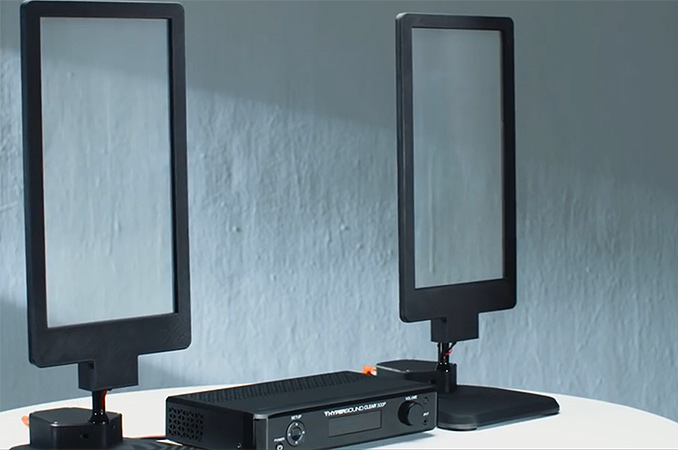Turtle Beach Demos HyperSound Glass: Transparent Speakers Made of Glass
by Anton Shilov on June 28, 2016 6:00 PM EST- Posted in
- Speakers
- Turtle Beach
- HyperSound

Turtle Beach has announced that it had built its first transparent directional speakers featuring its HyperSound technology. The company demonstrated an early prototype of the speaker set publicly at the E3 trade show, but does not reveal when it expects the new tech to be commercialized.
Turtle Beach’s HyperSound Glass is comprised of multiple layers of thin transparent films, which can generate a narrow beam of ultrasound (high frequency sound) that delivers audio to a targeted listener (by the time it reaches the targeted spot, ultrasound becomes normal sound) and does not disturb others. Since the speakers produce ultrasound, the audio is inaudible in a very short distance from the speakers and is also claimed to be imperceptible in locations outside of the targeted area. To generate that beam, Turtle Beach uses the HyperSound software technology, which the company already commercializes, but not with glass. According to Turtle Beach, the sound generated by its films maintains clarity over longer distances than traditional loudspeakers (which may well be correct given the size of the “driver”), but the company does not reveal technical specifications of its devices, such as frequency response or wattage.
As pointed out above, the HyperSound tech is not something completely new. At present, Turtle Beach offers its HyperSound Clear 500P speaker system for those with hearing problems and their families. The HyperSound Clear 500P do not feature transparent speakers, but can beam loud audio to a specific spot, whereas those around will hear normal volume audio. The product does not use glass/films, but a special metallic grill to produce ultrasound.
Turtle Beach claims that the HyperSound Glass could be integrated into various monitors, desktop speakers, and automotive dashboard glass to deliver sounds to specific listeners. Turtle Beach does not plan to build products based on the HyperSound technology exclusively itself, but can license it to others.
The HyperSound Glass technology is still work in progress and we have no idea when this tech could be commercialized. Nonetheless, since Turtle Beach showed off prototypes at E3, it is highly likely that the technology is nearly ready.
Source: Turtle Beach










21 Comments
View All Comments
JanSolo242 - Thursday, June 30, 2016 - link
Thanks for that link to Wikipedia. I went through some of the links on Wikipedia which ultimately took me to the URL below where the Limitations of "Audio Spotlight" were covered.http://econtact.ca/14_4/copeland_spotlight.html
"Limitations
The major drawback is that the Audio Spotlight is basically a tweeter. From my experience, it does not produce usable content below 800 Hz. Fortunately, the sensitivity to localization is much greater in the presence band (1 to 5 kHz), and the fidelity of the Audio Spotlight in that range is acceptable. In a solo performance using just Audio Spotlights, this limited bandwidth is not a problem. In terms of spatialization, a solo Audio Spotlight performance would be like attending a flute recital. However, not unlike the orchestration challenges of incorporating a solo part for a flute in an orchestral work, the Audio Spotlights also requires specific orchestration strategies when incorporating them into systems with full-range loudspeaker systems. One rather extreme strategy is to diminish the amplitude of presence band frequencies in the full-range loudspeakers. However, more interesting solutions can arise when artists begin composing pieces with the Audio Spotlights in mind and assign content appropriate for their unique characteristics."